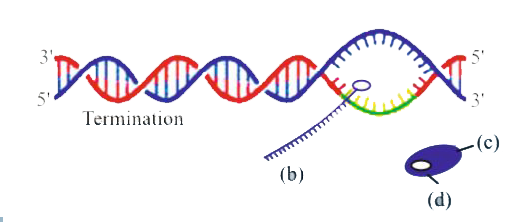In translation, br a: Site is cytoplasm whether a cell is eukaryotic or 10 prokaryotic. Br b. Site is same as of transcription, in eukaryotic cell. Br d. Both enzymes and energy are involved. Br d. Site is same as of transcription, in prokaryotic cell. Choose the set of correct statements
a,b,c
a,b,d
b,c,d
a,c,d
To solve the question regarding the statements about translation, we will analyze each statement one by one to determine which ones are correct.
1. Statement A: "Site is cytoplasm whether a cell is eukaryotic or prokaryotic."
- In both eukaryotic and prokaryotic cells, translation occurs in the cytoplasm. In eukaryotic cells, ribosomes are found in the cytoplasm, and in prokaryotic cells, ribosomes are also present in the cytoplasm. Therefore, this statement is correct.
2. Statement B: "Site is same as of transcription, in eukaryotic cell."
- In eukaryotic cells, transcription occurs in the nucleus, while translation occurs in the cytoplasm. Since these two processes occur in different locations, this statement is incorrect.
3. Statement C: "Both enzymes and energy are involved."
- Translation requires various enzymes, such as aminoacyl-tRNA synthetase and peptidyl transferase, and it also requires energy in the form of GTP (and ATP in some cases). Therefore, this statement is correct.
4. Statement D: "Site is same as of transcription, in prokaryotic cell."
- In prokaryotic cells, both transcription and translation occur in the cytoplasm because prokaryotes do not have a membrane-bound nucleus. Thus, this statement is correct.
Conclusion:
The correct statements are A, C, and D.
Final Answer:
- The set of correct statements is: A, C, and D.
---
- In both eukaryotic and prokaryotic cells, translation occurs in the cytoplasm. In eukaryotic cells, ribosomes are found in the cytoplasm, and in prokaryotic cells, ribosomes are also present in the cytoplasm. Therefore, this statement is correct.
- In eukaryotic cells, transcription occurs in the nucleus, while translation occurs in the cytoplasm. Since these two processes occur in different locations, this statement is incorrect.
- Translation requires various enzymes, such as aminoacyl-tRNA synthetase and peptidyl transferase, and it also requires energy in the form of GTP (and ATP in some cases). Therefore, this statement is correct.
- In prokaryotic cells, both transcription and translation occur in the cytoplasm because prokaryotes do not have a membrane-bound nucleus. Thus, this statement is correct.
The correct statements are A, C, and D.
- The set of correct statements is: A, C, and D.
Similar Questions
Knowledge Check
A few statements are made about the characteristics of prokaryotic and eukaryotic cells.
Mark the correct statement .AAll prokaryotes lack nuclear envelope but nuclear envelope is present in mitochondria of eukaryotes.BAll eukaryotes have a cell wall surrounding the cell membrane but cell wall is absent in mycoplasma.CAll eukaryotic cells are identical but all prokaryotic cells are not identical.DMost of the eukaryotic chromosomes are associated with histone protein but the genome of chloroplast lack histones.Assertion. Ribosomes are the only cytoplasmic organelles found in both eukaryotic and prokaryotic cells.
Reason. Ribosomes are cell's protein factories that are essential for cells.AIf both Assertion and Reason are true and Reason is the correct explanation of Assertion.BIf both Assertion and Reason are true but Reason is not the correct explanation of Assertion.CIf Assertion is true but Reason is false.DIf both Assertion and Reason are false.Assertion. Prokaryotic cells lack cyclosis in their cytoplasm.
Reason. Eukaryotic cells lack respiratory enzymes in the plasmalemma.AIf both Assertion and Reason are true and Reason is the correct explanation of Assertion.BIf both Assertion and Reason are true but Reason is not the correct explanation of Assertion.CIf Assertion is true but Reason is false.DIf both Assertion and Reason are false.
The process of termination during transcription in a prokaryotic cell is being represented here. Name the label a,b,c and d.

View Solution(a) Give reason for -
(i) Both strands of DNA are not copied during transcription.
(ii) Transcription and translation in bacteria can be coupled.
(b) Differentiate between the process of transcription in prokaryotes and eukaryotes
View SolutionRead the following statements:
i. Membrane-bounded inclusion bodies are not found in prokaryotic cells.
ii. Ribosomes are the site of protein synthesis.
iii. Pili are the surface of the bacteria which may play a role in motility .
iv. The cell membrane of prokaryotes is structurally similar to the eukaryotes.
Choose the option with the correct statements.
View SolutionCompare the statements A and B .
Statement A : RNA produced during transcription in eukaryotic cells cannot be straight away used in photosynthesis. Statement B : RAN splicing phenomena help in the removal of exons .
Choose the correct description.
View SolutionRead the following statements, br Action potential propagates across the neuronal membrane br Repolarisation decreases the responsiveness of neuronal membrane to further stimulus br At resting stage, neuronal membrane is negatively charged on the inside and positively charged on the outside. br For every 2Na+ ions which are transported inside the cell, Na+−K+ pump transports 3K+ ions to outside,Choose the option which includes correct statements only,
View Solution
